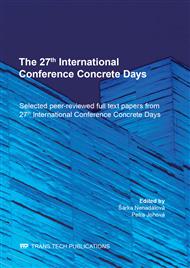[1]
H. F. Bender. Proceedings of a Symposium on Underground Siting of Nuclear Power Plants. Hannover, (1981).
Google Scholar
[2]
F. Buchhardt. Some comments on the concept of underground siting of nuclear power plants, - a critical review of the recently elaborated numerous studies. Nuclear Engineering and Design, 59(2):217-230, (1980).
DOI: 10.1016/0029-5493(80)90196-x
Google Scholar
[3]
M. Buser and W. Wildi. Milestones in the History of Swiss Nuclear Power and Radioactive Waste Disposal, https://www.nuclearwaste.info/milestones-in-the-history-of-swiss-nuclear-power-andradioactive-waste-disposal/, 2015, Accessed: 2020-11-28.
Google Scholar
[4]
R. Chylík, J. Fládr, P. Bílý, and T. Trtík. Mechanical properties and durability of crumb rubber concrete. In Building up Efficient and Sustainable Transport Infrastructure 2017, volume 236, page 012093, Phoenix AZ, 2017. IOP Conference Series: Materials Science and Engineering.
DOI: 10.1088/1757-899x/236/1/012093
Google Scholar
[5]
R. Chylík, J. Fládr, P. Bílý, T. Trtík, and L. Vráblík. An analysis of the applicability of existing shrinkage prediction models to concretes containing steel fibres or crumb rubber. Journal of Building Engineering, 24:100729, 2019.[6] S. Coll. NEUTRAL SWEDEN QUIETLY KEEPS NUCLEAR OPTION OPEN, https://www.washingtonpost.com/archive/politics/1994/11/25/neutral-sweden-quietly-keepsnuclear-option-open/754e8f39-b158-4ec5-812c-63592ac1889d/, 1994, Accessed: 2020-11-28.
DOI: 10.1016/j.jobe.2019.02.021
Google Scholar
[7]
C. Dahlgren. The Flooding Incident at the Agesta Pressurized Heavy Water Nuclear Power Plant, Swedish Nuclear Power Inspectorate, 1996, https://www.stralsakerhetsmyndigheten.se/en/publications/reports/safety-at-nuclear-powerplants/1996/9651/. Master's thesis.
Google Scholar
[8]
G. Duplat. NUCLEAIRE: CHOOZ ARRETE EN 1991, https://www.lesoir.be/art/nucleaire-chooz-arrete-en-1991-t-19890609-Z01Q3Z.html, 1989, Accessed: 2020-11-28.
Google Scholar
[9]
C. Fang, M. Ali, T. Xie, P. Visitin, and A. H. Sheikh. The influence of steel fibre properties on the shrinkage of ultra-high performance fibre reinforced concrete. Construction and Building Materials, 242:117993, (2020).
DOI: 10.1016/j.conbuildmat.2019.117993
Google Scholar
[10]
Federal Inspectorate for Nuclear Safety IFSN. Série de Lucens : absence de dommage majeur après l'accident, https://www.ensi.ch/fr/2012/05/24/serie-de-lucens-absence-de-dommage-majeur-apreslaccident/, 2012, Accessed: 2020-11-28.
Google Scholar
[11]
Federal Inspectorate for Nuclear Safety IFSN. Série de Lucens : des conditions strictes pour la phase d'essai, https://www.ensi.ch/fr/2012/04/26/lucens-des-conditions-strictes-pour-la-phase-dessai/, 2012, Accessed: 2020-11-28.
Google Scholar
[12]
Federal Inspectorate for Nuclear Safety IFSN. Série de Lucens : difficultés rencontrées lors de la phase d'essai, https://www.ensi.ch/fr/2012/05/03/lucens-difficultes-rencontrees-lors-de-la-phase-dessai/, 2012, Accessed: 2020-11-28.
Google Scholar
[13]
Federal Inspectorate for Nuclear Safety IFSN. Série de Lucens : décision de création de la première centrale nucléaire exclusivement suisse, https://www.ensi.ch/fr/2012/04/12/lucens-decision-de-creation-de-la-premiere-centralenucleaire-exclusivement-suisse/, 2012, Accessed: 2020-11-28.
Google Scholar
[14]
Federal Inspectorate for Nuclear Safety IFSN. Série de Lucens : l'arrêt définitif de la centrale nucléaire expérimentale, https://www.ensi.ch/fr/2012/05/17/serie-de-lucens-larret-definitif-de-la-centrale-nucleaireexperimentale/, 2012, Accessed: 2020-11-28.
Google Scholar
[15]
Federal Inspectorate for Nuclear Safety IFSN. Série de Lucens : l'heure de naissance de la centrale nucléaire expérimentale, https://www.ensi.ch/fr/2012/04/19/lucens-lheure-de-naissance-de-la-centrale-nucleaireexperimentale/, 2012, Accessed: 2020-11-28.[16] P. A. Garric. Au cœur d'une centrale en démantèlement, https://www.lemonde.fr/planete/article/2012/03/05/au-c-ur-d-une-centrale-en-demantelement1648096-3244.html, 2012, Accessed: 2020-11-28.
DOI: 10.4414/pc-f.2012.00093
Google Scholar
[17]
Global Security. Krasnoyarsk-26 / Zheleznogorsk Mining and Chemical Combine [MCA], http://www.globalsecurity.org/wmd/world/russia/krasnoyarsk-26-nuc.htm, 2003, Accessed: 2020-11-28.
Google Scholar
[18]
S.-E. Hole and T. Haugstad. Oppdaget kritisk feil: Lekkasje i Haldenreaktoren, https://www.tu.no/artikler/oppdaget-feil-oppstart-av-haldenreaktoren-ma-utsettes-i-fleremaneder/434244, 2018, Accessed: 2020-11-28.
Google Scholar
[19]
T. Holtebekk and M. Guttormsen. Haldenreaktoren, https://snl.no/Haldenreaktoren, 2018, Accessed: 2020-11-28.
Google Scholar
[20]
Institutt for energiteknikk. Dette er Haldenreaktoren, https://web.archive.org/web/20160205164943/, http://www.ife.no/no/ife/detaljer/hrp/detteerhrp, 2016, Accessed: 2020-11-28.
Google Scholar
[21]
Institutt for energiteknikk. Haldenreaktoren stenges, men IFE satser videre i Halden, https://web.archive.org/web/20180729141653/, https://www.ife.no/no/ife/ife-nyheter/2018/haldenreaktoren-stenges-men-ife-satser-videre-ihalden, 2018, Accessed: 2020-11-28.
DOI: 10.26226/morressier.5b5f4338b56e9b005965bf34
Google Scholar
[22]
Institutt for energiteknikk. The Halden Project 1958-2008, https://www.oecd-nea.org/jointproj/docs/halden/the-halden-project-1958-2008.pdf, 2018, Accessed: 2020-11-28.
Google Scholar
[23]
International Atomic Energy Agency. On-site disposal as a decommissioning strategy, https://www-pub.iaea.org/MTCD/publications/PDF/te-1124-prn.pdf, 1999, Accessed: 2020-11-28.
Google Scholar
[24]
B. A. Klemczak. Modeling thermal-shrinkage stresses in early age massive concrete structures - comparative study of basic models. Archives of Civil and Mechanical Engineering, 14(4):721-733, (2014).
DOI: 10.1016/j.acme.2014.01.002
Google Scholar
[25]
Le Monde. LA CENTRALE NUCLÉAIRE FRANCO-BELGE DE CHOOZ A ÉTÉ COUPLÉE AU RÉSEAU, https://www.lemonde.fr/archives/article/1967/04/05/la-centrale-nucleaire-franco-belge-dechooz-a-ete-couplee-au-reseau-2623503-1819218.html, 1967, Accessed: 2020-11-28.
Google Scholar
[26]
H. Mohammadhosseini, R. Alyousef, N. H. A. S. Lim, M. M. Tahir, H. Alabduljabbar, and A. M. Mohamed. Creep and drying shrinkage performance of concrete composite comprising waste polypropylene carpet fibres and palm oil fuel ash. Journal of Building Engineering, 30:101250, (2020).
DOI: 10.1016/j.jobe.2020.101250
Google Scholar
[27]
C. W. Myers and N. Z. Elkins. Underground collocation of nuclear power reactors and repository to facilitate the post-rennaissance expansion of nuclear power - 9113. In WM2009 Conference, Phoenix AZ, 2009.[28] C. W. Myers, J. M. Mahar, and J. F. K. a N. Z. Elkins. Underground nuclear parks: new approach for the deployment of nuclear energy systems. Underground Spaces I, 102:63-70, (2008).
DOI: 10.2495/us080071
Google Scholar
[29]
Nettavisen. IFE legger ned Haldenreaktoren - ansatte skuffet, https://www.nettavisen.no/nyheter/innenriks/ife-legger-ned-haldenreaktoren-ansatteskuffet/3423507702.html, 2018, Accessed: 2020-11-28.
Google Scholar
[30]
Nuclear Engineering International. Excavating Chooz A, https://www.neimagazine.com/features/featureexcavating-chooz-a, 2010, Accessed: 2020-11-28.
Google Scholar
[31]
B. V. Sreekantan and B. N. Karkera. HILL CONTAINMENT OF NUCLEAR POWER PLANTS. Bengaluru: National Institute of Advanced Studies, (2012).
Google Scholar
[32]
M. Vinkler and J. L. Vítek. Drying and shrinkage of massive concrete wall segments - 3 years experiment and analytical observations. Materials and Structures, 52:29, (2019).
DOI: 10.1617/s11527-019-1329-x
Google Scholar
[33]
Wikipedia. Haldenreaktoren, https://no.wikipedia.org/w/index.php?title=Haldenreaktorenoldid=20940275, 2020, Accessed: 2020-11-28.
Google Scholar
[34]
Wikipedia. Ågestaverket, https://sv.wikipedia.org/w/index.php?title=2020, Accessed: 2020-11- 28.
Google Scholar
[35]
World Data Centers in Russia and Ukraine. Краснояркий Горно-Химический комбинат, http://www.wdcb.ru/mining/krasn/krasn26.html, 1, Accessed: 2020-11-28.
Google Scholar
[36]
World Nuclear News. Radioactive release from Norwegian research reactor, http://www.world-nuclear-news.org/RS-Radioactive-release-for-Norwegian-research-reactor2510165.html/, 2016, Accessed: 2020-11-28.
Google Scholar


